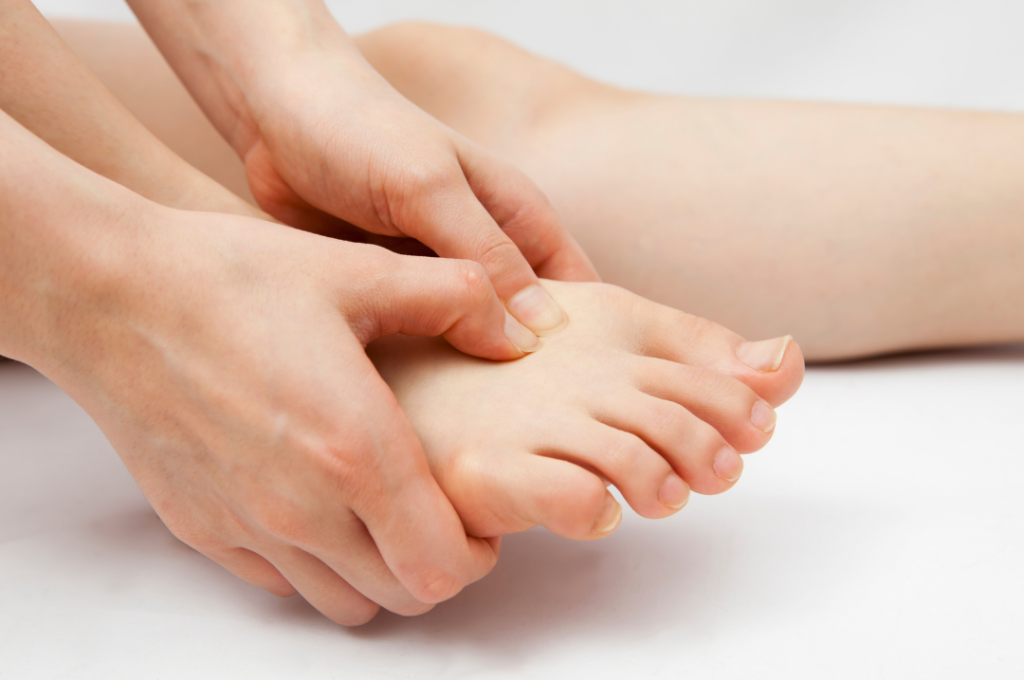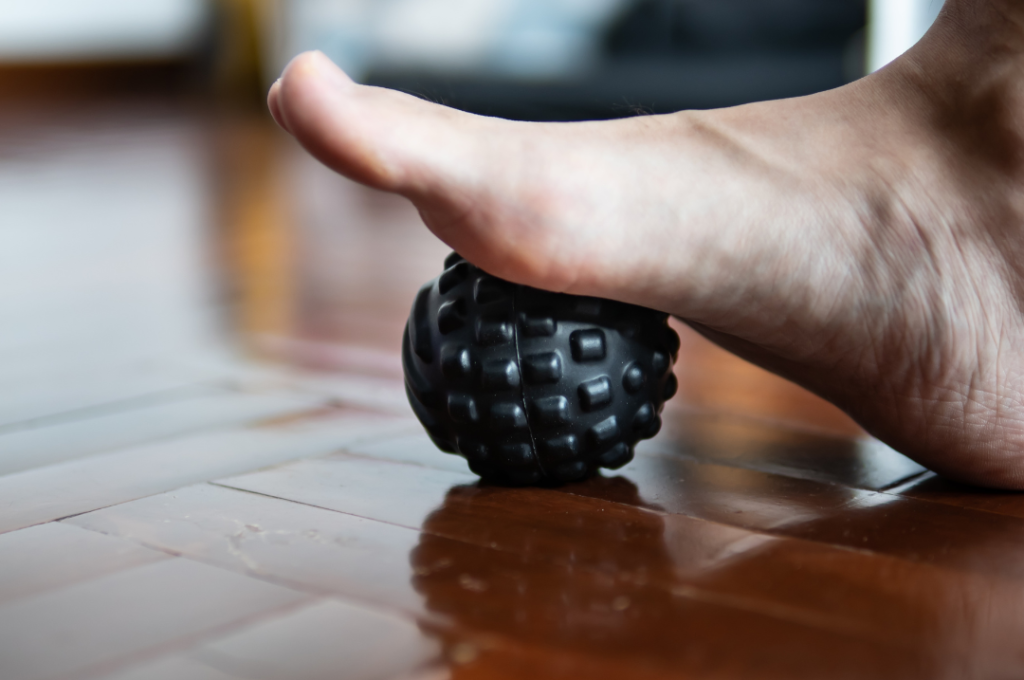 Given that we place almost our entire body weight onto the balls of our feet as we push off the ground to take each step, injury and pain to the ball of the foot is a common complaint seen by our experienced podiatrists here in Masterton, regardless of your level of physical activity.
Given that we place almost our entire body weight onto the balls of our feet as we push off the ground to take each step, injury and pain to the ball of the foot is a common complaint seen by our experienced podiatrists here in Masterton, regardless of your level of physical activity.
As such, we have developed comprehensive, effective and evidence-based treatment plans for ball of foot pain that vary depending on the cause of your pain. Here are some of the most common causes of pain that we see and treat.
Morton’s Neuroma
A Morton’s neuroma is a build-up or thickening of the fibrous tissue surrounding a nerve that runs between the long bones of your feet (the metatarsals). The resulting lump puts pressure on the nerves between the toes, often between the third and fourth toes, causing numbness, burning pain, swelling, tenderness and general discomfort.
Metatarsalgia
Metatarsalgia is a broad term used to describe pain in the ball of the foot. Generally, the pain and any associated inflammation occur due to excessive pressure or impact, such as from running, jumping, or wearing shoes that are too tight. The term metatarsalgia can also include one or more of the conditions in this list and is sometimes a term assigned to pain experienced in older adults who begin to lose the fat pad under the ball of their feet.
Capsulitis or Synovitis
 Capsulitis is the inflammation, and subsequent pain, of the ligaments that comprise the joint capsule surrounding one or more of the joints in the ball of the foot. Synovitis is the inflammation of the synovial membrane that lines the joints in the body, and often occurs together with capsulitis to produce pain at the ball of the foot.
Capsulitis is the inflammation, and subsequent pain, of the ligaments that comprise the joint capsule surrounding one or more of the joints in the ball of the foot. Synovitis is the inflammation of the synovial membrane that lines the joints in the body, and often occurs together with capsulitis to produce pain at the ball of the foot.
Plantar Plate Tears
Plantar plate tears occur when a thick ligament that runs along the bottom of the foot, called the plantar plate, is damaged, most often due to overuse and overloading. Plantar plate tears are typically felt beneath the ball of the foot beneath the second toe (metatarsal head). They are more common in middle-aged women, and alongside the pain, the toes may splay as a result, making the forefoot wider. This injury can cause clawing of the toes and a ‘V’-shaped gap between two toes. The pain and altered foot alignment can make comfortable shoes hard to find.
Sesamoiditis
Sesamoiditis describes the inflammation of the two sesamoid bones beneath the big toe. Similar to the kneecap in the knee, the sesamoids function as a pulley to increase the leverage of the tendons controlling the big toe. In severe cases in active people who have flat feet, these bones can fracture. Sesamoiditis occurs more frequently in those who land heavily on one foot before jumping, as well as cricketers who land heavily on one foot before they bowl the ball.
Stress Fracture
Stress fractures are small micro-cracks within a bone that often affect the metatarsals and metatarsal heads (on the long bones of the foot). This creates pain that gradually worsens, starting off as a dull ache or discomfort and progressing to significant pain without treatment.
Bursitis
 In bursitis, the fluid-filled sacs that cushion the joints in the ball of the foot called the bursa become inflamed, causing pain and swelling. We have bursa all around our body, and the inflammation is typically caused by overloading and excess pressure to these structures, which leads to damage.
In bursitis, the fluid-filled sacs that cushion the joints in the ball of the foot called the bursa become inflamed, causing pain and swelling. We have bursa all around our body, and the inflammation is typically caused by overloading and excess pressure to these structures, which leads to damage.
Gout
Gout is a type of arthritis caused by the buildup of uric acid crystals in the joints, which can cause sudden, intense pain and swelling in the ball of the foot. This most often affects the big toe. Gout comes in flares, so once you know you have gout, you must be careful and work with your health practitioners to try to avoid recurrent flares and episodes.
Plantar warts, corns, calluses and embedded objects are also common causes of pain in the ball of the foot.
How Is Pain In The Ball Of The Foot Treated?
After you receive the right diagnosis from having a comprehensive assessment with your podiatrist, we’ll be able to discuss the best treatment options for you based on your symptoms, severity, regular activities and other personal factors. We always work with you and your life when planning your recovery. The earlier these conditions are diagnosed, the better the treatment outcome. Treatment may include strapping, bracing, foot orthotics, shockwave, foot mobilisation therapy, removal of embedded objects, offloading areas of pressure, exercises (stretching, strengthening and proprioception training), footwear modification, as well as corn, callus and plantar wart removal.
FAQs
What are the common causes of pain at the ball of the foot?
Pain at the ball of the foot can be caused by various factors, including metatarsalgia (inflammation or injury to the metatarsal heads), a Morton’s neuroma (thickening of the nerve between the toes), sesamoiditis (inflammation of the sesamoid bones), stress fractures, arthritis, plantar plate tears, and overuse or improper footwear.
How is the cause of pain at the ball of the foot diagnosed?
To determine the cause of pain at the ball of the foot, we typically perform a thorough physical examination, evaluate your medical history, and may use medical imaging such as X-rays, MRI scans, or ultrasound imaging. These help assess the bones, joints, soft tissues, and identify any underlying conditions.
Can certain footwear contribute to pain at the ball of the foot?
Yes, improper footwear can contribute to pain at the ball of the foot. Shoes that lack proper cushioning, support, or have a narrow toe box can increase pressure on the metatarsal heads, leading to discomfort and pain. High-heeled shoes can also shift weight to the ball of the foot, exacerbating symptoms.
What are the treatment options for pain at the ball of the foot?
Treatment for pain at the ball of the foot depends on the underlying cause. Aside from the treatment options we’ve listed above, some at-home pain management options you can try include rest, activity modification, wearing shoes with a wider toe box, applying ice to reduce inflammation, and nonsteroidal anti-inflammatory drugs (NSAIDs).
Can exercises or stretches help alleviate pain at the ball of the foot?
Exercises and stretches may help alleviate pain at the ball of the foot, depending on the cause of your pain and its severity, by strengthening the foot muscles, improving flexibility, and promoting better biomechanics. Specific exercises may include toe curls, marble pickups, calf stretches, and toe stretches.
Can custom orthotics or shoe inserts help with pain at the ball of the foot?
Absolutely, custom orthotics are often beneficial in relieving pain at the ball of the foot, though your podiatrist will discuss this with you once they understand the cause of your pain. Orthotics are designed to provide support, cushioning, and proper alignment to alleviate pressure on the metatarsal heads and redistribute weight more evenly. If you need orthotics, your podiatrist will assess your foot mechanics and prescribe custom orthotics that address your specific needs.
Can pain at the ball of the foot be a chronic condition?
Pain at the ball of the foot can become chronic if not properly addressed or if the underlying cause persists. This is why it’s so important to seek professional evaluation and treatment to prevent the condition from worsening or recurring. With appropriate care, including rest, appropriate footwear, orthotics, and activity modifications, most cases of pain at the ball of the foot can be effectively managed.
